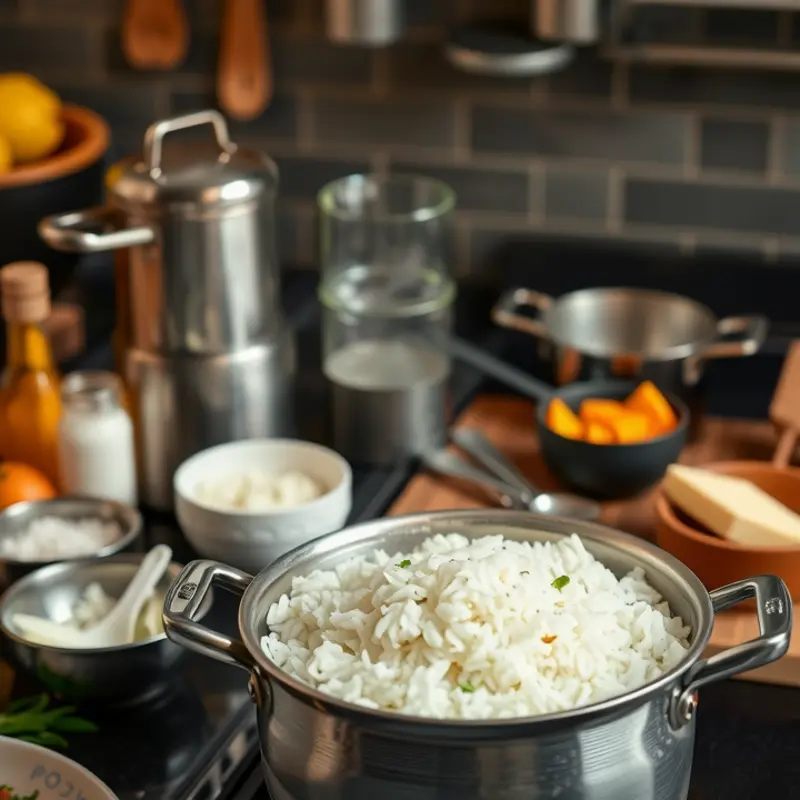Achieving fluffy rice is a delightful skill that can elevate any meal. Whether you’re a home cook just starting or a seasoned chef wanting to improve, mastering rice texture can transform a simple dish into a culinary masterpiece. In this guide, discover essential tips and techniques to make perfectly fluffy rice every time. Say goodbye to sticky, clumpy rice and embrace the light, airy grains that will complement any of your favorite dishes.
Choosing the Right Rice

Mastering the art of perfectly cooked, fluffy rice begins with choosing the right type of rice. Each variety, from long-grain to short-grain, possesses unique characteristics that affect its texture and cooking method.
Long-Grain Rice varieties are often celebrated for their slender shape and ability to stay separate after cooking. This category includes popular types such as jasmine and basmati rice. Ideal for pilafs and as an accompaniment to robust dishes, long-grain rice requires careful attention to the water-to-rice ratio to prevent it from becoming sticky.
Medium-Grain Rice is plumper and tends to stick together slightly more than long-grain, but it still retains a tender bite. Varieties like arborio, commonly used in risottos, and bomba, often seen in paellas, belong here. The key to their desirable creamy texture lies in gradual stirring and slow cooking.
Short-Grain Rice is even plumper and generally more sticky. It’s perfect for dishes that benefit from a more adhesive texture, such as sushi or rice pudding. When cooking short-grain rice, it’s essential to use slightly less water to maintain a balance between moisture and starch release.
Rinsing rice is a critical step often overlooked in achieving the perfect texture. By rinsing your rice until the water runs clear, you remove excess surface starch that can cause clumping. This is particularly important for long and medium-grain rice.
In addition to rinsing, soaking rice before cooking can significantly enhance its texture and flavor. Soaking allows each grain to absorb water, leading to a more even and tender cook. A 30-minute soak generally suffices, paving the way for quick and even cooking.
Arguably, the most pivotal aspect of cooking rice is the water-to-rice ratio. This ratio is crucial to preventing undercooked or mushy grains. Typically, for long-grain varieties, a ratio of 1.5 cups of water to 1 cup of rice works well. Medium-grain rice benefits from a 2:1 ratio, while short-grain rice requires slightly less water to achieve that signature sticky texture.
For those striving to reduce waste in their cooking practice, consider exploring low-waste cooking methods. These approaches emphasize mindful preparation, including precise measurement of rice and water to minimize leftovers.
In conclusion, choosing the right type of rice for your desired dish is an essential step towards perfecting the art of cooking fluffy rice. Understanding the properties and needs of each rice variety not only enhances texture and flavor but also elevates your culinary creations to new heights.
Cooking Methods for Fluffy Rice

Once you’ve selected the right variety, mastering the cooking method is key to achieving fluffy rice. Multiple techniques can be employed, each suited to different needs and situations. Here, we delve into the most effective methods: stovetop, rice cooker, and the absorption method.
Stovetop cooking requires attention but is ideal for those who appreciate hands-on involvement. Start by rinsing the rice thoroughly to remove excess starch. Use a 1:2 rice-to-water ratio for most long-grain varieties. Bring water to a boil, add rice, then lower to a gentle simmer. Cover the pot with a lid, allowing steam to circulate. This method typically takes about 18 minutes, but check for water absorption to ensure readiness.
Rice cookers simplify the process, offering set-it-and-forget-it convenience. Follow the specified instructions for your rice type, usually printed on the rice cooker’s guideline sticker. Most recommend a water ratio similar to stovetop cooking. The rice cooker takes care of timing and temperature control, switching to ‘keep warm’ once done. Despite its ease, resting the rice for an additional 10 minutes post-cooking will enhance fluffiness.
The absorption method, often complemented by seasoned cooks, involves precise water measurements and tight lid control to trap steam. After washing your rice, use a 1:1.5 rice-to-water ratio. Bring contents to a gentle boil, reduce heat, and cover. The rice should cook for about 15 minutes. The hallmark of this method lies in the resting phase: remove from heat and let sit undisturbed for another 10 minutes, allowing residual steam to finish the job.
Regardless of your chosen method, the importance of resting cannot be overstated. It permits the moisture to distribute evenly, dissipating any clumps that can form if disturbed too soon. After resting, fluffing is the final step to achieving a light texture. Gently use a fork to separate the grains, enhancing the appearance and mouthfeel of your dish.
Mastering each of these methods ensures you’ll produce fluffy rice every time, supporting a fundamental characteristic of many cuisines. For those interested in complementing their meals with minimal effort, explore practical ingredient batching to streamline your preparation process further.
With these techniques in your culinary toolkit, you’ll always have perfectly fluffy rice, no matter the occasion!
Final words
Perfecting your rice technique will enhance your overall cooking skills and impress family and friends alike. By choosing the right type of rice and employing effective cooking methods, you can consistently achieve fluffy, flavorful results. Remember that practice makes perfect, so don’t hesitate to experiment with different varieties and techniques. Each step brings you closer to rice perfection. Enjoy the delicious and versatile addition that fluffy rice brings to your favorite recipes, from stir-fries to curries. Happy cooking!







